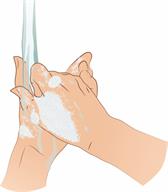Contact Precautions
Contact precautions are guidelines around caring for a person who has a disease that can be spread by contact with the patient or the patient's environment. Contact can happen through:
Contact between the patient's skin and another person's skin (skin-to-skin contact).
Contact with bodily fluids, such as saliva, stool (feces), blood, and fluid from open wounds.
Contact with items in the environment that have been contaminated with infected bodily fluids.
Examples of diseases spread by contact with the patient or the patient's environment include methicillin-resistant Staphylococcus aureus (MRSA), vancomycin-resistant enterococci (VRE), Clostridioidesdifficile, respiratory syncytial virus (RSV), and some types of severe acute respiratory syndrome (SARS). Following these guidelines helps to prevent the disease from spreading to others.
Guidelines for patients

If you have a disease that can be spread by skin-to-skin contact or by contact with bodily fluids or items within the environment, follow these guidelines during your stay in the hospital:
Check with your nurse before you leave the room where you are being treated.
Wear a gown and a covering or bandage (dressing) over the infected area if you need to leave your room.
Wash your hands often with soap and water for at least 20 seconds. This is the best way to prevent spread of the disease. If soap and water are not available, use an alcohol-based hand sanitizer.
Guidelines for visitors
If you are visiting a person who has a disease that can be spread by direct contact with the person, or through contact with the person's environment, follow these guidelines:
Check with a nurse before you enter a room that has a sign that says "Contact Precautions."
If a nurse says that you can go into the room, you will be asked to wash your hands with soap and water or use an alcohol-based hand sanitizer. You will also be asked to wear a gown and gloves.
Do not take off your gown or gloves in the room until you are about to leave.
Do not eat or drink in the room unless you ask a nurse first.
Do not touch anything in the room unless you ask a nurse first.
- Right before you leave the room:
Take off your gloves first. Be careful not to touch the outside of the gloves.
Take off your gown. Be careful not to touch the outside of the gown.
Leave your gloves and gown in the room as told by the nurse.
Wash your hands with soap and water for at least 20 seconds. This is the best way to prevent spread of the disease. If soap and water are not available, use an alcohol-based hand sanitizer.
Summary
-
Contact precautions are guidelines to prevent the spread of diseases through direct contact with a person's skin, a person's bodily fluids, or items within the person's environment.
-
If you are a patient, ask a nurse before you leave your room. Wear a gown and a covering or bandage (dressing) over the infected area if you need to leave the room.
-
If you are a visitor, wear a gown and gloves. Do not touch anything in the room. Do not eat or drink in the room.
-
For both patients and visitors, washing hands often with soap and water for at least 20 seconds is the best way to prevent infection. If soap and water are not available, use an alcohol-based hand sanitizer.
This information is not intended to replace advice given to you by your health care provider. Make sure you discuss any questions you have with your health care provider.
 If you have a disease that can be spread by skin-to-skin contact or by contact with bodily fluids or items within the environment, follow these guidelines during your stay in the hospital:
If you have a disease that can be spread by skin-to-skin contact or by contact with bodily fluids or items within the environment, follow these guidelines during your stay in the hospital: